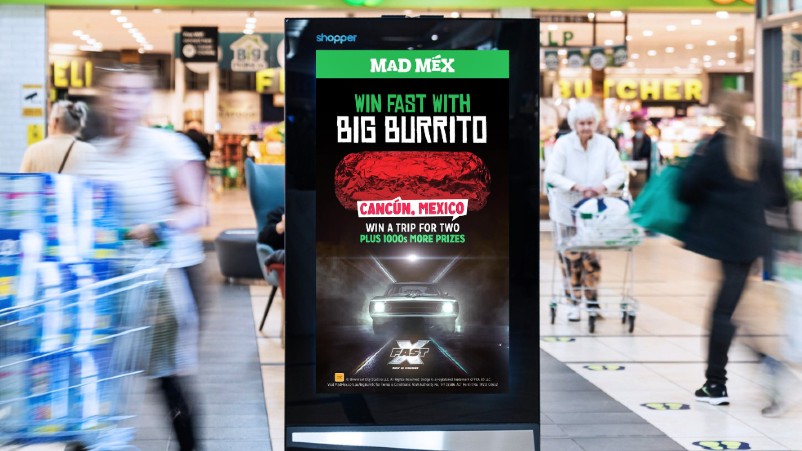'A massive result!' Flexibility of programmatic DOOH campaign helps Mad Mex drive a 9% uplift in restaurants, cut wastage and extend time in market

Fast food chain Mad Mex was able to drive a 9 per cent uplift in sales in restaurants within a proximity of its latest programmatic digital out-of-home campaign that also demonstrated the flexibility and agility of the channel. Just as importantly, digital efficiency helped to extend the life of the campaign.
What you need to know:
- By utilising the flexibility and agility of digital out-of-home channels, fast food outlet Mad Mex was able to drive a 9 per cent increase in sales in restaurants that fell within the proximity of the campaign, as well as a 7 per cent increase in transactions.
- An initial campaign in April delivered solid results, but by fine-tuning its analysis around like-for-like performances during the second campaign, and by utilising the flexibility of Vistar Media's digital out-of-home channel, it was able to double that in the second campaign.
- The efficiency of DOOH, compared to traditional OOH also helped it significantly extend the campaign's time in market.
That's a massive result. That is really significant. Look at it from a sales point of view, anything incremental on the previous year is freaking fantastic.
For Mexican fast food business Mad Mex, shopping centres are ground zero – that's where most of its stores are located. When planning an outdoor campaign, buying media in close proximity to the shopping centre is therefore critical.
“That’s particularly true when we're looking at the bottom of the funnel metrics – sales,” said Nick Cook, GM marketing, Mad Mex when speaking of a two-part campaign he ran with the help of Vistar Media and Hearts & Science.
The first campaign, according to Vistar, had a reach of 2.9 million people and achieved a CPM of $21.
Flexibility around timing and creative now provided by digital out-of-home campaigns has improved efficiency and effectiveness for the business.
Mad Mex ran two related campaigns last year. The first kicked off in April and ran for three months. A second campaign was implemented towards the end of the year following the first campaign's success, said Cook.
“We needed fundamentally, a sales-driving campaign and we needed to maximise our time in market - those were the two critical type of metrics we wanted to go after," he said.
Historically, Mad Mex would be in market for about 25 per cent of the year when utilising traditional out-of-home. “Having the opportunity to stretch that out as far as possible was really important," Cook said.
Having tried outdoor for the middle as well as bottom of the funnel, Mad Mex has typically seen the channel work best for the latter approach.
“We found sites that were within one kilometre of all of our restaurants, because that proximity was absolutely critical. You can do that with traditional buying, but it's harder to do day-parting, which is the the key factor for us,” Cook said.
The brand was able to minimise wastage by turning off ads when the shops were closed, a key advantage over traditional out-of-home. Just as importantly, the QSR could present all those images of tasty Mexican goodness (and in the case of the second campaign a special offer) just as those midday hunger-grumbles started to emerge.
To ensure it was making the most of the time it was in market, Mad Mex implemented a regular running report sent to the agency team at Hearts & Science.
“And whoever was below like-for-like, we would then prop them up by switching on particular sites. That’s how we made sure we stretched it out to the three-month period, where we probably would have got putting up half of that using a traditional media buy," Cook explained.
Understanding the impact of the campaign was made easier as there was a control group where the restaurants did not have a campaign running nearby. (The fact that the control group was mostly made up of corporate sites also made it a more popular campaign with the franchisees!)
“We saw some pretty good results in terms of sales figures for control versus the non-control and we initially saw around a 2 per cent uplift in sales for the non-controlled stores," Cook told Mi3.
By the time the second campaign came around, Mad Mex was achieving a 3-4 per cent uplift.
Mad Mex II: Learnings
The first campaign was a little less targeted, and Mad Mex didn’t initially have like-for-like metrics set up. According to Cook, that was probably the key change between the first and second campaigns.
"In the second campaign, we started to do the like-for-like piece where every morning we'd say: 'Well this is what that store recorded at the same time for the same period last year and then this is what the incremental uplift in sales was',” he said. “That's a massive result. That is really significant. Look at it from a sales point of view, anything incremental on the previous year is freaking fantastic. But a 3-4 per cent uplift is pretty massive."
Creative and messaging was another significant input. "I think the key thing is we didn't advertise the retail offers we promoted in the restaurant. The intention was to get people thinking about it," Cook continued.
“And whether they redeemed the offer or not was somewhat immaterial. It was more they actually visited as a result and therefore spent money. In an ideal world, you almost don't want them to take the offer up."
That said, the nature of the message did make a difference.
“The first one was more of a product campaign and the second one was a retail offer. The first one was a traditional burrito campaign and the second one was a value offer. And that's where it became a lot more bottom of the funnel sales focused," Cook said.
Hearts & Science head of client service, Gail Halbert, stressed the importance of agility and flexibility in the digital OOH approach. "We were specifically at that lead into lunchtime. And then further on top of that, we knew the stores that weren't performing the day before. So we were looking at that, then up-weighting before that lunch hour.
"One of the key insights we had from our strategy was we have such a short window of time to be able to influence buyer decisioning. That proximity to the restaurant was so key. Then to have a really strong message playing within that was really important."
According to Managing Director APAC of Vistar Media, Ben Baker, “This tech solution enabled Mad Mex to have a significantly longer retail media presence as sites were activated programmatically only when required, ensuring the limited media budget wasn’t chewed through, minimising wastage and maximising effectiveness.”


